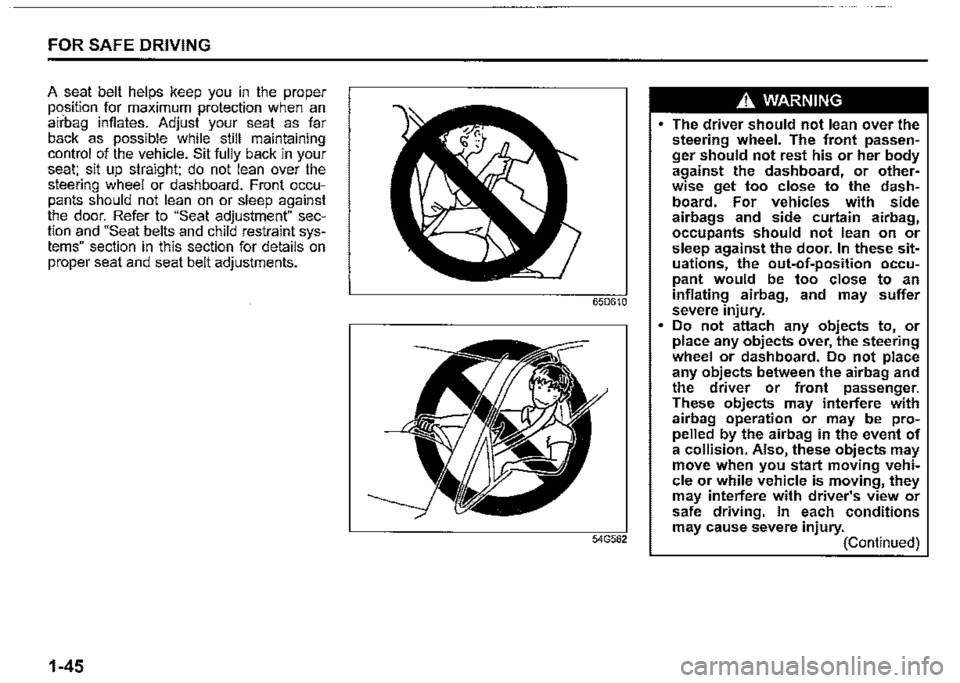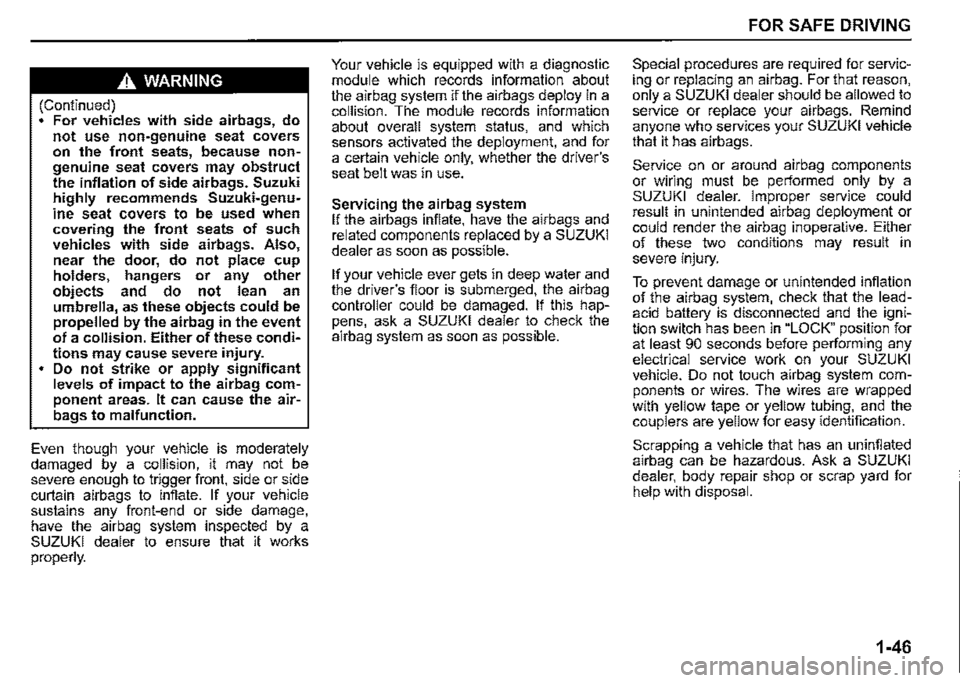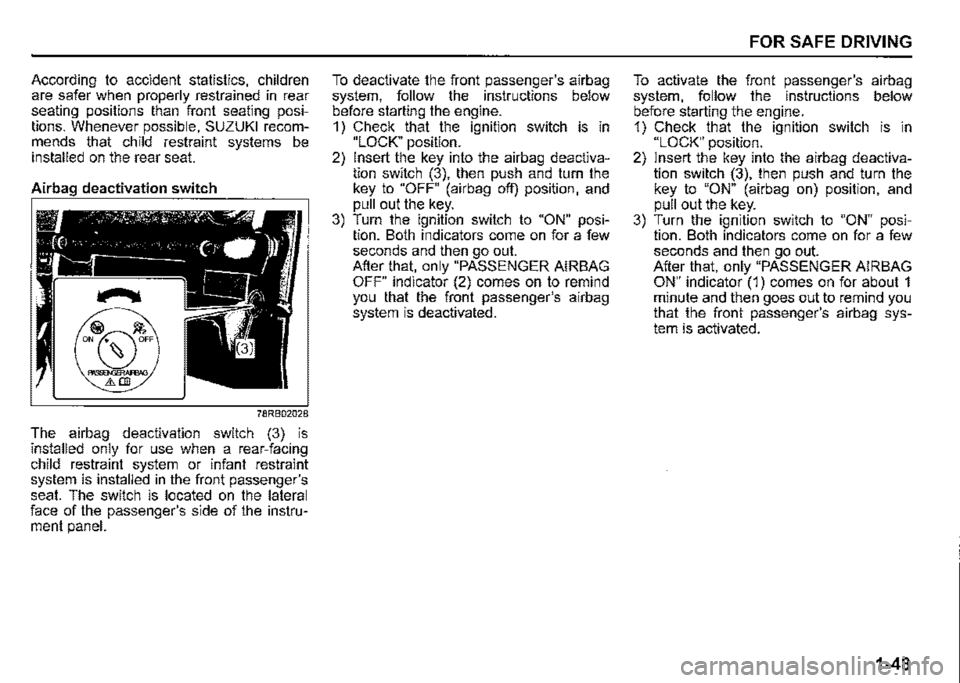SUZUKI JIMNY 2022 Repair Manual
Manufacturer: SUZUKI, Model Year: 2022, Model line: JIMNY, Model: SUZUKI JIMNY 2022Pages: 421, PDF Size: 6.35 MB
Page 61 of 421

80J103
Collision that the front of your vehicle goes under the bed of a truck etc.
80J104
Collision with a utility pole or stumpage
80J105E
Collision with a fixed wall or guardrail at left and right angles of greater than about 30 degrees (1) from the front of your vehicle
80J106
Frontal collision with a fixed wall that
FOR SAFE DRIVING
Front airbags do not inflate Front airbags do not infiate in rear impacts, side impacts or rollovers, etc. However, these might inflate in a strong impact.
80J120
• Impact from the rear
80J119
does not move or deform at less than • Impact from the side about 25 km/h (15 mph)
1-40
Page 62 of 421

FOR SAFE DRIVING
80J110
• Vehicle rollover
NOTE: For vehicle equipped with the "Emergency
road assistance -global navigation satellite system (ERA-GLONASS)", refer to "Emergency Road Assistance -Global Navigation Satellite System (ERA-GLONASS)" in "For Russia and other countries adopting ERA-GLONASS" in the "SUPPLEMENT" section for further information.
1-41
Side airbags and side curtain air
bags
68KM090
Side airbags and side curtain airbags are designed to inflate in severe side impact collisions when the ignition switch is in "ON" position.
Side airbags and side curtain airbags are not designed to inflate in frontal or rear collisions, rollovers or minor side collisions, since they would offer no protection in those types of accidents. Only the side airbag and side curtain airbag on the side of the vehicle that is struck will inflate. However, in a frontal angle collision, the side airbags and side curtain airbags may inflate. Since an airbag deploys only one time during an accident, seat belts are needed to restrain occupants from further movements during the accident.
Therefore, an airbag is not a substitute for seat belts. To maximize your protection, always fasten your seat belts. Be aware that no system can prevent all possible injuries that may occur in an accident.
Side airbags
78RB02025
Side airbags are located in the part of the front seatbacks closest to the doors. The "SRS AIRBAG" labels are attached to the seatbacks to identify the location of the side airbags.
Page 63 of 421

Side curtain airbags
SRS AIRBAG
78RB02026
Side curtain airbags are located in the roof lining. The words "SRS AIRBAG" are melded into the pillar to identify the location of the side curtain airbags.
A WARNING
If the airbag stored place is damaged or cracked, the airbag system may not work properly, which could result in serious injury in the event of a collision. Have your vehicle inspected by a SUZUKI dealer.
Conditions of side airbags and side curtain airbags deployment (inflation)
80J119
Impacts from the side at about a right angle by a general passenger car to your vehicle at more than about 30 km/h (19 mph) or in a greater impact
Side airbags and side curtain airbags may inflate in a strong impact Side airbags and side curtain airbags may inflate even in a frontal collision, if there is a strong impact to the lateral direction.
• Frontal collision
FOR SAFE DRIVING
52RM20730
• Hitting a curb or bump
80J100E
• Falling into a deep hole or ditch
1-42
Page 64 of 421

FOR SAFE DRIVING
80J101
• Landing hard or falling
1-43
Side airbags and side curtain airbags may not inflate
=
80J121
,,
'>
ij = ~ ,
*'4:I
80J122
Impact from the side to the vehicle body other than the passenger compartment
80J123
Impact from the side at an oblique angle
~~,c] fr.
_;,~" 0 1 "1
\
80J124
Impact from the side by a high hood vehicle
Page 65 of 421

80J125
Impact from the side by a motorcycle or
bicycle
80J126
Collision with a utility pole or stumpage
FOR SAFE DRIVING
Side airbags and side curtain airbags do not inflate How the system works
80J120
• Impact from the rear
80J110
• Vehicle rollover
In a frontal collision, the crash sensors will detect rapid deceleration, and if the controller judges that the deceleration represents a severe frontal collision, the controller will trigger the infiators. If your vehicle is equipped with side airbags and side curtain airbags, crash sensors will detect a side collision, and if the controller judges that the side collision is severe enough, it will trigger the side airbag and side curtain airbag infiators. The infiators inflate the appropriate airbags with nitrogen or argon gas. The infiated airbags provide a cushion for your head (front airbags and side curtain airbags only) and upper body. The airbag inflates and defiates so quickly that you may not even realize that it has activated. The airbag will neither hinder your view nor make it harder to exit the vehicle.
Airbags must infiate quickly and forcefully in order to reduce the chance of serious or fatal injuries. However, an unavoidable consequence of the quick infiation is that the airbag may irritate bare skin, such as the facial area against a front airbag. Wash off any residue as soon as possible to prevent skin irritation. Also, upon inflation, a loud noise will occur and some powder and smoke will be released. These conditions are not harmful and do not indicate a fire in the vehicle. Be aware, however, that some airbag components may be hot for a while after infiation.
1-44
Page 66 of 421

FOR SAFE DRIVING
A seat belt helps keep you in the proper po_sition for maximum protection when an airbag infiates. Adjust your seat as far back as possible while still maintaining control of the vehicle. Sit fully back in your seat; sit up straight; do not lean over the steering wheel or dashboard. Front occupants should not lean on or sleep against the door. Refer to "Seat adjustment" section and "Seat belts and child restraint systems" section in this section for details on proper seat and seat belt adjustments.
1-45
A WARNING
• The driver should not lean over the steering wheel. The front passenger should not rest his or her body against the dashboard, or otherwise get too close to the dashboard. For vehicles with side airbags and side curtain airbag, occupants should not lean on or sleep against the door. In these situations, the out-of-position occupant would be too close to an inflating airbag, and may suffer severe injury. • Do not attach any objects to, or place any objects over, the steering wheel or dashboard. Do not place any objects between the airbag and the driver or front passenger. These objects may interfere with airbag operation or may be propelled by the airbag in the event of a collision. Also, these objects may move when you start moving vehicle or while vehicle is moving, they may interfere with driver's view or safe driving. In each conditions may cause severe injury. (Continued)
Page 67 of 421

A WARNING
(Continued) For vehicles with side airbags, do not use non-genuine seat covers on the front seats, because nongenuine seat covers may obstruct the inflation of side airbags. Suzuki highly recommends Suzuki-genuine seat covers to be used when covering the front seats of such vehicles with side airbags. Also, near the door, do not place cup holders, hangers or any other objects and do not lean an umbrella, as these objects could be propelled by the airbag in the event of a collision. Either of these conditions may cause severe injury. Do not strike or apply significant levels of impact to the airbag component areas. It can cause the airbags to malfunction.
Even though your vehicle is moderately damaged by a collision, it may not be severe enough to trigger front, side or side curtain airbags to inflate. If your vehicle sustains any front-end or side damage, have the airbag system inspected by a SUZUKI dealer to ensure that ii works properly.
Your vehicle is equipped with a diagnostic module which records information about the airbag system if the airbags deploy in a collision. The module records information about overall system status, and which sensors activated the deployment, and for a certain vehicle only, whether the driver's seat belt was in use.
Servicing the airbag system If the airbags inflate, have the airbags and related components replaced by a SUZUKI dealer as soon as possible.
If your vehicle ever gets in deep water and the driver's floor is submerged, the airbag controller could be damaged. If this happens, ask a SUZUKI dealer to check the airbag system as soon as possible.
FOR SAFE DRIVING
Special procedures are required for servicing or replacing an airbag. For that reason, only a SUZUKI dealer should be allowed to service or replace your airbags. Remind anyone who services your SUZUKI vehicle that it has airbags.
Service on or around airbag components or wiring must be performed only by a SUZUKI dealer. Improper service could result in unintended airbag deployment or could render the airbag inoperative. Either of these two conditions may result in severe injury.
To prevent damage or unintended inflation of the airbag system, check that the leadacid battery is disconnected and the ignition switch has been in "LOCK" position for at least 90 seconds before performing any electrical service work on your SUZUKI vehicle. Do not touch airbag system components or wires. The wires are wrapped with yellow tape or yellow tubing, and the couplers are yellow for easy identification.
Scrapping a vehicle that has an uninflated airbag can be hazardous. Ask a SUZUKI dealer, body repair shop or scrap yard for help with disposal.
1-46
Page 68 of 421

FOR SAFE DRIVING
Front passenger airbag deactiva
tion system (if equipped)
(2)
78RB02027
The front passenger's front airbag system must be deactivated if a child restraint system is to be installed on the front passenger's seat. When the ignition switch is turned to "ON" position, "PASSENGER AIRBAG ON" indicator (1) or "PASSENGER AIRBAG OFF" indicator (2) shows whether the front passenger's airbag system is activated or deactivated.
1-47
When the front passenger's airbag system is activated, both "PASSENGER AIRBAG ON" indicator (1) and "PASSENGER AIRBAG OFF" indicator (2) come on for a few seconds and then go out. After that, only "PASSENGER AIRBAG ON" indicator (1) comes on for about 1 minute and then goes out.
When the front passenger's airbag system is deactivated, both "PASSENGER AIRBAG ON" indicator (1) and "PASSENGER AIRBAG OFF" indicator (2) come on for a few seconds and then go out. After that, only "PASSENGER AIRBAG OFF" indicator (2) comes on.
When you activate or deactivate the front passenger's airbag system, check which indicator is on before starting the engine.
Side airbags, side curtain airbags and seat belt pretensioners are not connected to the airbag deactivation system. Even if the front passenger's airbag system is deactivated, side airbags, side curtain airbags and seat belt pretensioners are still activated.
58MS030
.A WARNING
When using child restraint system on the front passenger's seat, the front passenger's airbag system must be deactivated; otherwise deployment of the front passenger's airbag could result in the death or serious injury of the child.
.A WARNING
Check that the front passenger's airbag system is activated and "PASSENGER AIRBAG ON" indicator (1) is on whenever there is no child restraint installed on the front passenger's seat.
Page 69 of 421

According to accident statistics, children are safer when properly restrained in rear seating positions than front seating positions. Whenever possible, SUZUKI recommends that child restraint systems be installed on the rear seat.
Airbag deactivation switch
78RB02028
The airbag deactivation switch (3) is installed only for use when a rear-facing child restraint system or infant restraint system is installed in the front passenger's seat. The switch is located on the lateral face of the passenger's side of the instrument panel.
To deactivate the front passenger's airbag system, follow the instructions below before starting the engine. 1) Check that the ignition switch is in "LOCK" position. 2) Insert the key into the airbag deactivation switch (3), then push and turn the key to "OFF" (airbag off) position, and pull out the key. 3) Turn the ignition switch to "ON" position. Both indicators come on for a few seconds and then go out. After that, only "PASSENGER AIRBAG OFF" indicator (2) comes on to remind you that the front passenger's airbag system is deactivated.
FOR SAFE DRIVING
To activate the front passenger's airbag system, follow the instructions below before starting the engine. 1) Check that the ignition switch is in "LOCK" position. 2) Insert the key into the airbag deactivation switch (3), then push and turn the key to "ON" (airbag on) position, and pull out the key. 3) Turn the ignition switch to "ON" position. Both indicators come on for a few seconds and then go out. After that, only "PASSENGER AIRBAG ON" indicator (1) comes on for about 1 minute and then goes out to remind you that the front passenger's airbag system is activated.
1-48
Page 70 of 421

.FOR SAFE DRIVING
Exhaust gas warning
52D334
A WARNING
Avoid breathing exhaust gases. Exhaust gases contain carbon monoxide, a potentially lethal gas that is colorless and odorless. Since carbon monoxide is difficult to detect by itself, take the following precautions to help prevent carbon monoxide from entering your vehicle. • Do not leave the engine running in garages or other confined areas. (Continued)
1-49
A WARNING
(Continued) • Do not park with the engine running for a long period of time, even i~ an open area. If it is necessary to s,t for a short time in a parked vehicle with the engine running, check that the air intake selector is set to "FRESH AIR" and the blower is at high speed. • Avoid operating the vehicle with the tailgate or trunk open. If it is necessary to do so, check that the sunroof (if equipped) and all windows are closed, and the blower is at high speed with the air intake selector set to "FRESH AIR". To allow proper operation of your vehicle's ventilation system, keep the air inlet grill in front of the windshield clear of snow, leaves or other obstructions at all times. • Keep the exhaust tailpipe area clear of snow and other material to help reduce the buildup of exhaust gases under the vehicle. This is particularly important when parked in blizzard conditions. Have the exhaust system inspected periodically for damage and leakage. Any damage or leakage should be repaired immediately.